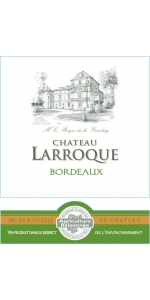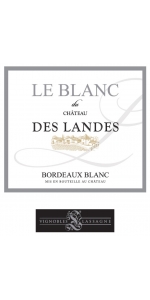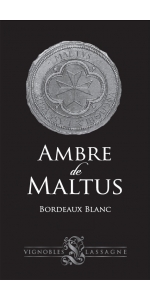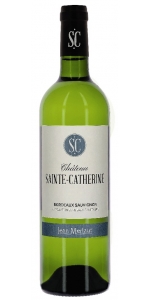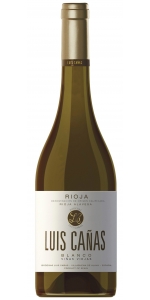Larroque Bordeaux Blanc 2022
12 bottles with free shipping for: $192.00
| BUY MORE! SAVE MORE! | ||||||||||||||||
|
| Country: | France |
| Region: | Bordeaux |
| Winery: | Larroque |
| Grape Type: | Sauvignon Blanc |
| Vintage: | 2022 |
| Bottle Size: | 750 ml |
Larroque Bordeaux Blanc is made from 73% Sauvignon Blanc and 27% Colombard.
No oak.
Color : Pale yellow with green tints.
Nose : Complex aromas of white flowers, exotic fruits, citrus and boxwood, with a touch of minerality.
Mouth : Aromatic, with a nice richness and freshness. Predominant flavors of tart, crisp fruit.
Marie-Christine, the daughter of Henri Ducourt, purchased this prestigious left-bank property in 1979, which lies on the border of the Graves appellation.
The 60-hectare vineyard was rapidly replanted and the château building, which dates from 1348, was restored.
Our family now produces three different-colored wines there: red, white and rosé.
Grown on loamy-clay soil.
Harvest : Machine harvesting in the cool, early morning
Maceration : Skin-contact maceration for several hours, depending on ripeness, and pressing
Fermentation : Beginning of the cold alcoholic fermentation (12°C / 53°F) then an increase in temperature to finish the fermentation at 20°C / 68°F.
Enjoy this wine as an aperitif or during the meal with fish, seafood or chicken salad.
Marie Christine, the daughter of Henri Ducourt, purchased this prestigious left-bank property in 1979, which lies on the border of the Graves appellation. The 60-hectare vineyard was rapidly replanted and the château building, which dates from 1348, was restored. The family now produces three different-colored wines there: red, white and rosé.
In 1858, Ducourt family settled at Château des Combes in Ladaux, a small rural village in the south east of Bordeaux, in the heart of Entre-Deux-Mers area. Over time, new generations have followed in their footsteps; a passion for wine has become a profession, and their knowledge and the estate have grown ever greater as they have been passed down the line.
Pierre Ducourt, then his children and his grand-children farmed several hectares of vines that belonged to the estate. The arrival of the grandfather, Henri Ducourt, at the property marked an important turning point in the family business. He, with the help of his three children (Marie Christine, Philippe and Bernard), decided to drastically revitalize the company and turned the family vineyard into one of Bordeaux’s largest winemaking facilities, with 450 hectares of land and 14 chateaus in 6 different AOC's.
The crocodile is the emblem of Henri Ducourt’s vigorous business spirit, which lives on today, as strong as ever, in each family member. And what better ambassadors could exist to remind people that Entre-Deux-Mers is where this family adventure began?
In 1962, Henri Ducourt, a young winemaker, used to work 14 hours a day managing the 20 hectares of vines he had inherited from his father. He had a good friend, his neighbor, who owned 14 hectares and used to work with his two sons. At this time, suffice to say that running a vineyard was not the career that parents wished for their children, preferring instead to steer them towards more stable jobs. Some though, including Henri, were obstinate and unwilling to part from the vineyard. So, hard-working and hard-headed, Henri Ducourt slowly but surely bought the land and the vines of the neighboring producers and found himself by the mid-80’s at the head of almost 300 hectares of vineyards! One day, as much to poke fun as through admiration, the son of his friend drew a crocodile on a sign to represent the tenacity, lucidity and cold-blooded business spirit of Henri Ducourt, then planted this sign among the far-reaching vines of his neighbor.
Amused by the gesture, Henri Ducourt was inspired by the crocodile when he rebuilt the winery and asked that the new vats were decorated with this symbol. Today, Henri’s children and grandchildren manage 450 hectares of vineyards, always persistent, ready for new challenges, and faithful to what their parents have built. The crocodile has since become the emblem of the family.
Graduated as Oenologist in 2002 (University of Toulouse).
Before joining Ducourt in 2014, he worked for various estates :
- Domaine de l’Hortus in Pic Saint Loup
- Les caves de Sieur d’Arques in Limoux
- Chateau Carbonnieux, Grand Cru Classé in Pessac Léognan
The Ducourt's have always known that quality grapes are essential for making a good wine. Therefore they take the utmost care in the vineyards, to get the best from every plot of land. The size of the business also allows them to make numerous investments in the latest tools, which enable to unite traditional knowledge with the latest technologies, and therefore become ever more precise and respectful of the environment in their work.
The latest equipment
They regularly invest in new equipment for two main reasons : a desire to constantly evolve and improve quality while reducing the amount of strenuous and dangerous work undertaken by their co-workers.
With the development of the vineyard's surface, the harvests are now carried out with the help of the latest generation of harvesting machines, which make it possible to collect the grapes in the cool of the morning. Harvest is quicker offering more flexibility and quality improvement.
Among the latest acquisitions is a machine that allows to plant using a GPS guidance as well as an innovative and precise spraying system and flexible frames that allow to reduce waste and the amount of treatment products used.
A Grand-Cru-worthy setup
The family invests in equipment that is worthy of a Grand Cru, and therefore push further in the constant quest for quality, which applies to the entire range of wines.
The new pressing system allows them to press the grapes in a completely inert environment to prevent any oxygenation of the juice and to preserve the aromas of each varietal, to obtain more intense and fresher wines. The wineries and the stainless-steel vats are thermo-regulated in order to keep the juice in the best conditions possible and to maintain complete control over the entire fermentation process. They have also invested in a cross-flow filtration system for filtering wines before bottling, which ensures optimal quality and no waste. Finally, to improve safety for the co-workers they also regularly invest in new equipment such as carbon-monoxide detectors, helping to prevent accidents including asphyxiation during the cleaning of the vats. The most recent investment to date involves the bottling line that was set up with the collaboration of the employees in order to reduce their workload.
6 generations of shared experience
They have the good fortune to be able to build on several generations of winemaking experience and produce wines that respect their local typicity. They frequently organize tastings of two old vintages so as to improve their understanding of the wines’ evolution over time, and so as to be able to really tell people when is the best time to drink the wines.
Larroque Bordeaux Blanc is made from 73% Sauvignon Blanc and 27% Colombard.
No oak.
Color : Pale yellow with green tints.
Nose : Complex aromas of white flowers, exotic fruits, citrus and boxwood, with a touch of minerality.
Mouth : Aromatic, with a nice richness and freshness. Predominant flavors of tart, crisp fruit.
Marie-Christine, the daughter of Henri Ducourt, purchased this prestigious left-bank property in 1979, which lies on the border of the Graves appellation.
The 60-hectare vineyard was rapidly replanted and the château building, which dates from 1348, was restored.
Our family now produces three different-colored wines there: red, white and rosé.
Grown on loamy-clay soil.
Harvest : Machine harvesting in the cool, early morning
Maceration : Skin-contact maceration for several hours, depending on ripeness, and pressing
Fermentation : Beginning of the cold alcoholic fermentation (12°C / 53°F) then an increase in temperature to finish the fermentation at 20°C / 68°F.
Enjoy this wine as an aperitif or during the meal with fish, seafood or chicken salad.
Le Blanc du Chateau des Landes Bordeaux Blanc is made from 50% Sauvignon Blanc and 50% Semillion.
Le Blanc du Chateau des Landes Bordeaux Blanc is a very fruity style of Bordeaux Blanc AOC. It has great aromatic intensity with white peach and citrus aromas.
No oak for this wine. The wine was aged on the lees for a few month in stainless steel tank.
Malolactic fermentation was completed as well in the process .
Excellent as an aperitif, it also goes very well with poultry and salads. If you have a chance to have access to fresh oyters, it is a great match as well.
The first vintage of this wine was made in 2018 as Nicolas Lassagne wanted to create an easy drinking wine that will be perfect as an aperitif in the summer time or to compliment salads and seafood in the winter time.
Ambre de Maltus Bordeaux Blanc is made from 70% Sauvignon Blanc, 30% Sémillion.
Malolactic fermentation.
The wine was aged in French Oak barrels for a few month (between 6 and 8 months depending on the barrel's toastiness and cooper)
Delicious with grilled fish or grilled vegetables
Chateau Sainte Catherine Bordeaux Blanc is made from 67% Semillon and 33% Sauvignon (Sauvignon Blanc and Sauvignon Gris).
A clear and brilliant color. The first nose reveals the minerality of our terroir (limestone subsoil). Fruity and delicate aromas come to sublimate this nose in a second time. On the palate, the wine is round and charming with sustained aromas throughout the tasting. (Small red fruits and white flowers).
Lexicon Sauvignon Blanc is made from 100% Sauvignon Blanc
Lexicon varietal wines are carefully selected by Fran Kysela to show the essence of each variety, along with its terroir of origin, both of which are essential elements of a good wine.
Sauvignon Blanc, historically known for the great white wines of Bordeaux and Sancerre, is gaining popularity in New Zealand. Lexicon Sauvignon Blanc was produced from grapes grown in the renowned Marlborough region, on the northern end of the island. Marlborough is recognized for growing outstanding Sauvignon Blanc with mouthwatering fresh acidity, balanced by intense tropical fruit notes.
Tropical, zesty & citrusy. Hints of guava, passion fruit & gooseberries.
Luis Canas Rioja Blanco is made from 90% Viura and 10% Malvasia (60+ years old vines)
Barrel fermented for 3.5 months in new French oak barrels.
Alcohol: 13,5º
Total acidity: 6,5 g./l.
Volatile acidity: 0,25 g./l.
PH: 3,40
Free SO2: 25 mg./l.
Grapes harvested in small boxes to be selected manually on the table, bunch by bunch.
Beautiful golden yellow, with bright lemony highly-luminous reflections. The nose is fine, with great elegance, combined with floral and fruity tones.
The palate is dry with a crisp acidity that gives its freshness and vivacity, a structured and tasty finish of ripe fruit.
We recommend that you taste it at 8°C.
It is appropriate to accompany shellfish, crustaceans and grilled white fish or fish stews. It also blends elegantly with rice, soft cheeses, blue cheeses, all kinds of mushrooms and fresh fruit.
Review:
"Clean citrus, reductive matchstick, crushed stone, and white flower notes all emerge from the 2022 Rioja Blanco Vinas Viejas, an incredibly well-made, balanced white that has a layered mouthfeel, building richness, and a clean, crisp, mineral-laced, almost salty finish. It will be a dream with tapas or as a starter. The blend is 85% Viura, 10% Malvasia, and the rest Tempranillo Blanco."
- Jeb Dunnuck (Importer Highlight: Fran Kysela ; July 2024), 94 pts
- back
Dr. Loosen Riesling Eiswein is made from 100 percent Riesling.
This vibrant, racy dessert wine conjures flavors of densely packed pear, apple and guava, with an intense, nervy edge in the aroma. It is luscious, silky and juicy on the palate, with bright acidity giving it a crisp, dynamic finish.
Review:
Charles Heidsieck Vintage Brut is made from 57% Pinot Noir, 43% Chardonnay.
A beautiful golden robe offers glints of green accentuated by a delicate, dynamic effervescence. The initial nose introduces intense toasted and smoky notes along with ripe fruit. When swirled in the glass, the nose takes on a heartier dimension with touches of apricot and vineyard peaches. The aromatic concentration, due to a heat wave of several weeks, is reminiscent of the summer sun. The attack is taut and decisive. the creamy texture, the crisp fruitiness and spiced notes of cinnamon, licorice and pepper are the hallmark of the House style.
Review:
Aged for eight years on the lees before disgorgement, the Champagne is deliciously toasty with acidity and fine dryness.
-Wine Enthusiast 96 Points
Disgorged in January of 2023, the 2013 Champagne Millésime Brut was the last vintage from the cellar master for Heidsieck prior to Cyril Brun. The 2013 Champagne Millésime Brut is a bright straw yellow color and is based on the crus of Les Mesnil, Avize, Averney, and Aÿ. It’s fresh with aromas of wet stones, fresh quince, and fresh jasmine flowers. It has a chalky and focused texture, with ripeness to balance it out, and a long, graceful finish. At this stage, it feels more forward with 57% Pinot Noir and the rest Chardonnay. A more mineral-tinged expression, it has a lot of charm and the promise of longevity over the coming two decades. Drink 2024-2044. It will be interesting to see how the Pinot shows itself over time. 8 grams per liter dosage.
-Jeb Dunnuck 95 Points



